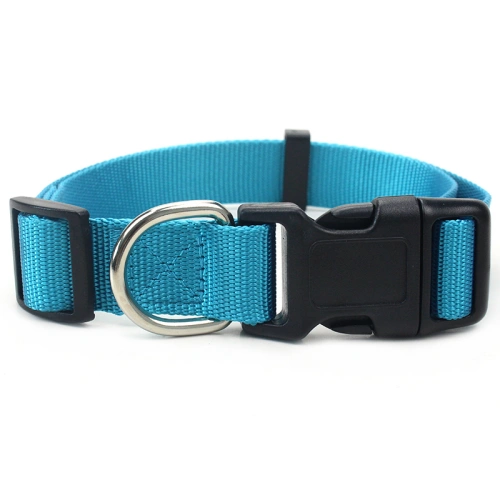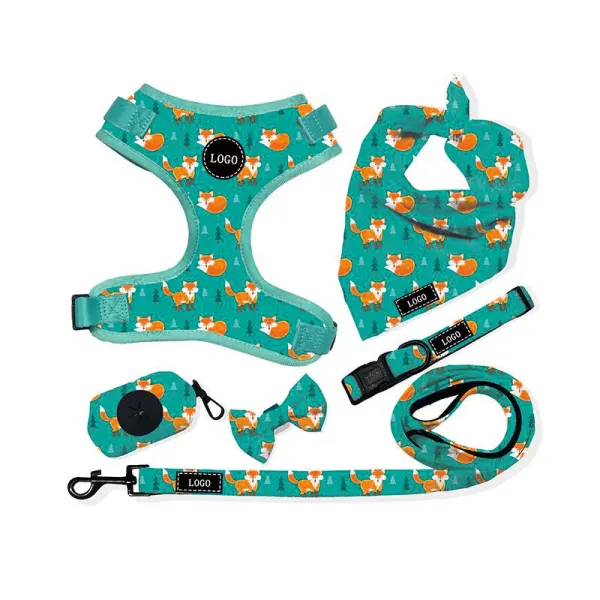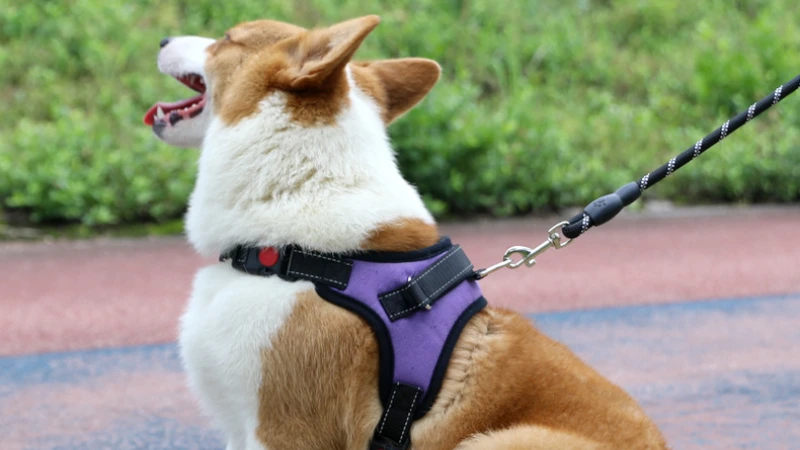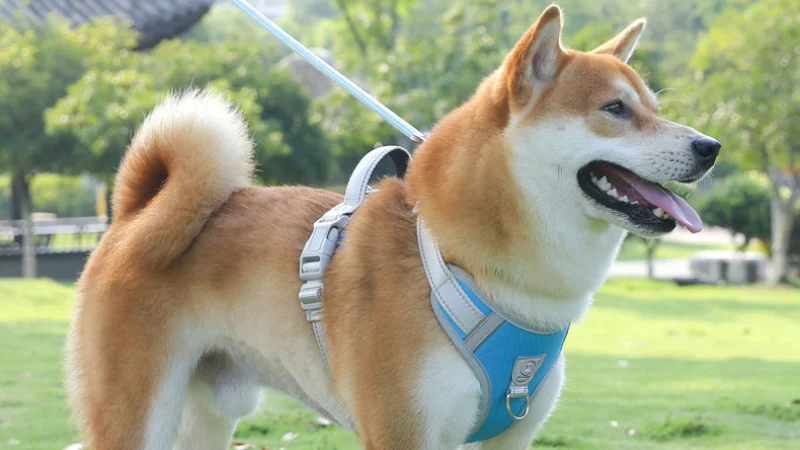Are you struggling to decide between a collar and a harness for your furry friend? You’re not alone! Many dog owners find themselves puzzled by this choice. Don’t worry, though – we’re here to help you figure out which option is best for you and your four-legged companion.
Let’s start by breaking down what exactly we’re talking about:
What is a dog collar?

A dog collar is probably what you picture when you think of walking a dog. It’s a simple strap that fits around your dog’s neck. Collars come in all sorts of colors, patterns, and materials. You can find them pretty much anywhere – from your local pet store to the grocery store down the street. They’re usually pretty cheap too, with prices ranging from about $5 to $30 for a basic collar.
What is a dog harness?

A dog harness is like a little vest for your pup. It wraps around their chest and body, giving you more control when you’re out for a walk. Harnesses come in different styles – some clip on the back, others on the front. They’re a bit pricier than collars, usually costing between $15 and $50, depending on the size and style.
Now that we know what we’re dealing with, let’s dive into the pros and cons of each:
Pros of using a dog collar
- Easy to wear all the time: Your dog can comfortably wear a collar 24/7, which is great for keeping ID tags handy.
- Simple to use: Just clip on the leash and go!
- Lots of style options: From simple nylon to fancy leather, there’s a collar to match every dog’s personality.
- Affordable: You can get a good quality collar without breaking the bank.
Cons of using a dog collar
- Choking risk: If your dog pulls hard or gets tangled, it could hurt their neck.
- Escape artists: Some clever pups can slip out of their collars, especially if they’re scared.
- Neck strain: Constant pulling can cause problems with your dog’s throat, eyes, or even thyroid.
- Less control: It’s harder to guide your dog or stop them from pulling with just a collar.
Pros of using a dog harness
- Better for pullers: Harnesses spread the force across your dog’s chest instead of their neck.
- Safer: There’s almost no risk of choking with a properly fitted harness.
- Harder to escape: A well-fitted harness is like a doggy Fort Knox – tough to wriggle out of!
- More control: You can guide your dog more easily, which is great for training.
- Discourages pulling: Especially front-clip harnesses can make pulling less rewarding for your dog.
Cons of using a dog harness
- Trickier to fit: Finding the right size can be a bit of a Goldilocks situation – not too big, not too small.
- Less comfortable for all-day wear: Harnesses can rub against your dog’s fur if worn too long.
- More challenging to put on: Especially if you’ve got a wiggly pup!
- Harder to attach tags: You’ll need to get creative with where you put your dog’s ID.
When to use a dog collar
Collars are great for:
- Everyday wear: Keep those important tags visible at all times.
- Short walks: If you’re just popping out for a quick potty break, a collar is fine.
- Well-trained dogs: If your pup walks calmly by your side, a collar works well.
- Working dogs: Dogs that need to move freely all day might prefer a collar.
When to use a dog harness
Harnesses shine in these situations:
- Long walks or hikes: When you need more control over an excited pup.
- Training sessions: Especially for dogs learning not to pull.
- Car rides: Harnesses can be safer in case of sudden stops.
- Dogs with neck issues: If your dog has had throat problems, a harness is gentler.
How to choose between a dog collar and a dog harness
Picking the right option isn’t always easy, but here are some tips to help:
- Consider your dog’s size: Tiny dogs often do better with harnesses to protect their delicate necks.
- Think about behavior: Does your dog pull like a sled dog? A harness might be better.
- Check the fit: Whether you choose a collar or harness, make sure you can fit 1-2 fingers between it and your dog’s body.
- Start young: If possible, get puppies used to both collars and harnesses early on.
- Be patient: If you’re switching an older dog from a collar to a harness, give them time to adjust.
Dog collar vs. dog harness – which one is better?
The truth is, there’s no one-size-fits-all answer. Many dog owners find that using both a collar and a harness works best. Here’s a common setup:
- Collar: Worn all the time for ID tags and quick trips outside.
- Harness: Used for longer walks, training sessions, or when more control is needed.
Remember, every dog is different. What works for your neighbor’s Labrador might not be right for your Chihuahua. It’s always a good idea to chat with your vet about your dog’s specific needs.
Let’s look at some common questions dog owners have:
FAQs
Q: Can I leave a harness on my dog all the time?
A: It’s not recommended. Harnesses can rub against your dog’s skin and mat their fur if worn constantly. Stick to using harnesses for walks and outdoor activities.
Q: Do harnesses really prevent pulling?
A: They can help! Front-clip harnesses are especially good at discouraging pulling. When a dog pulls, the harness turns them towards you instead of letting them forge ahead. About 60% of dog owners report less pulling after switching to a front-clip harness.
Q: Are harnesses safe for small dogs?
A: Yes, in fact, they’re often safer than collars for tiny pups. Small dogs and flat-faced breeds (like Pugs or French Bulldogs) can have breathing issues with collars. A well-fitted harness is usually a better choice for these dogs.
Q: How do I know if the collar or harness fits right?
A: For both collars and harnesses, you should be able to fit two fingers between the gear and your dog’s body. If you can’t, it’s too tight. If you can fit more than two fingers, it’s too loose.
Q: My dog hates putting on a harness. What can I do?
A: Patience is key! Start by letting your dog sniff and investigate the harness. Give treats when they show interest. Gradually work up to putting it on, always using positive reinforcement. About 80% of dogs adjust to harnesses within a week of consistent, positive training.
Conclusion: finding the perfect fit
Choosing between a dog collar and a harness doesn’t have to be a headache. Here’s a quick recap to help you decide:
- Consider your dog’s needs: Size, behavior, and health all play a role.
- Think about your lifestyle: Do you need all-day wear or just for walks?
- Don’t be afraid to use both: Many dogs benefit from having a collar for ID and a harness for walks.
- Proper fit is crucial: No matter what you choose, make sure it fits correctly.
- Be patient: It might take time for your dog to adjust to a new collar or harness.
Remember, the goal is to keep your dog safe, comfortable, and happy. Whether you choose a collar, a harness, or both, the most important thing is that it works for you and your furry friend.
Ready to find the perfect collar or harness for your pup?
Here at Wedogy, a pet products manufacturer in China. We understand that every dog is unique. That’s why we’re proud to be a leading manufacturer of both dog collars and harnesses. Our products are designed with your dog’s comfort and safety in mind, using high-quality materials and the latest pet gear technology.





